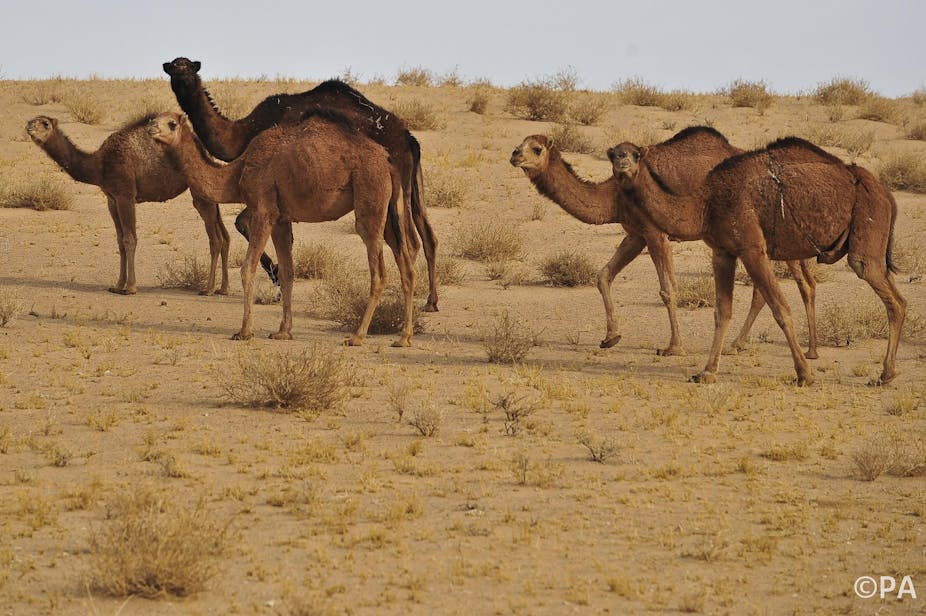The discovery that dromedary camels may be a key source of the virus behind Middle Eastern Respiratory Syndrome (MERS) looks to unravel one of the biggest mysteries surrounding outbreaks of the deadly disease - where it came from.
Saudi Arabia is the country most affected and of the 94 confirmed cases of MERS, 46 have died. Like a cold, it’s spread through coughing and sneezing and can go on to cause breathing difficulties and pneumonia. There is currently no cure and the majority of people are recorded to have caught the virus from an unknown source.
We know that MERS is caused by MERS coronavirus, a member of the coronavirus family that appeared in Saudi Arabia in 2012. Severe acute respiratory syndrome (SARS), which killed 800 in a 2003 pandemic, is also caused by a coronavirus. Bats have been linked to some closely related coronaviruses, which led to some speculation that they may be behind MERS.
But using blood serum samples to test for virus antibodies in livestock animals including sheep, goats and cows, scientists found they were only present in camels from Oman (and in some camels tested from the Canary Islands). This suggests that camels have been previously infected with MERS coronavirus or another closely related virus. By showing that these one-humped camels have a history of MERS-like infections, the new research brings us a step closer to working out how MERS is spread and why the virus is crossing over to humans in the Middle East.
There has been some anecdotal evidence of people who came down with MERS after contact with sick camels, but this is the first hard evidence that camels may be a missing link in the chain of transmission.
And it comes at a serendipitous time as the annual pilgrimage to Mecca, which will bring millions of people from around the world to roughly the geographical centre of the MERS-affected area, is due to begin in a couple of months.
Why so few human cases?
The primary goal of my laboratory, based at the University of Reading, is to understand how the virus is able to co-opt our cells, which enables it to spread, and to develop new drugs to stop the virus.
So far, a broad group of MERS-like viruses have been found in bats in Asia, Africa and Europe, suggesting that MERS coronavirus may have evolved in bats over the past few decades. However, the MERS coronavirus has so far only been found in people.
This raises a number of questions. Why there are so few human cases in comparison to camels which are widely infected, and why there is a particular link with Saudi Arabia and why now?
The Lancet study revealed that all the camels from Oman that were tested had evidence of previous infection, as well as 14% of those camels from the Canary Islands. This suggests that camels globally may have a long history of infection with MERS-like coronaviruses.
However, the research doesn’t tell us why the virus appears to have only recently started to infect humans and whether camels are directly involved, or whether some other source of the virus is common to both camels and man.
Antibodies
Most coronavirus infections come and go in less than a month. But antibodies, which are part of the immune response that helps to defeat the virus, can remain in the body for years after the infection clears up.
The new evidence is significant in showing that antibodies in camel blood can recognise and block the virus. But we have also yet to find out whether it is exactly the same as the virus that has spread to people. Antibodies only recognise a tiny part of one protein in the virus and can sometimes bind to distantly related viruses. This means they are a valuable clue in efforts to track down the source of a new disease but not conclusive in epidemiological detective work.
And antibodies can sometimes be misleading. In addition to finding antibodies in palm civets, a mammal native to Asia, the search for the origin of SARS coronavirus turned up red herrings such as a snake that allegedly had antibodies to a SARS-like coronavirus.
Palm civets are now thought to have been a key step in the spread of SARS to man, while snakes were at most a dead end for the virus, and probably cannot be infected by the SARS coronavirus. This is why it is important to isolate the virus from camels and confirm whether it is the same as the one that is infecting people.
The next big step will be to look for the virus itself in sick camels, and to find out whether the virus is changed in a way that makes it more likely to infect humans, in the same way that SARS coronavirus did by passing through palm civets.
Other work has shown that MERS coronavirus is still changing, and that change makes it difficult to predict the future of MERS. Still, this study a great first step towards measures to prevent further human infection.

